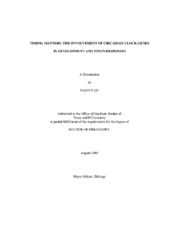| dc.description.abstract | Most members of the PAS (PER-ARNT-SIM) protein family are transcription factors, mediating development and adaptive responses to the environment, such as circadian rhythms and toxin responses. Because the PAS domain mediates protein-protein interactions and functional cross-talk between distinct biological processes, we hypothesized that PAS genes in the circadian clockworks, namely Per1 and Per2, may be involved in development and toxin responses, which are modulated by other PAS members. To explore the possible role of clock genes in development, we examined mammary epithelial cells in vitro and the mouse mammary gland in vivo for evidences of changes in clock gene expression during different stages of development and differentiation. Our results showed that Per1 and Bmal1 expression were up-regulated in differentiated HC-11 cells, whereas Per2 mRNA levels were higher in undifferentiated cells. A similar differentiation-dependent profile of clock gene expression was observed in mouse mammary glands; Per1 and Bmal1 mRNA levels were elevated in late pregnant and lactating mammary tissues, whereas Per2 expression was higher in proliferating virgin and early pregnant glands. These data suggest that circadian clock genes may play a role in mouse mammary gland development. To examine clock gene function in toxin responses, we evaluated whether disruption or inhibition of Per1 and/or Per2 alters toxin-induced activity of the AhR signaling pathway in the mouse mammary gland and liver. We assessed the activation of the AhR signaling pathway in response to 2,3,7,8-Tetrachlorodibenzo-p-dioxin (TCDD), a prototypical AhR agonist, by analyzing the mRNA abundance of its two target genes, cytochrome P450, subfamily I, polypeptide 1 (Cyp1A1) and Cyp1B1. Our results showed that the targeted disruption of Per1, but not Per2, significantly increases the TCDD-induced p450 expression in the mammary gland and liver in vivo. Similar changes in TCDD-mediated p450 expression were observed in vitro using mammary primary cultures of mammary cells derived from from Per1ldc, Per2ldc and Per1ldc/Per2ldc mutant mice and Hepa1c1c7 cells subjected to siRNA-mediated inhibition of Per1 or Per2. These discoveries suggest that the clock gene Per1 may modulate toxin responses perhaps by functioning as a negative regulator for TCDD-mediated activation of the AhR signaling pathway. | en |


